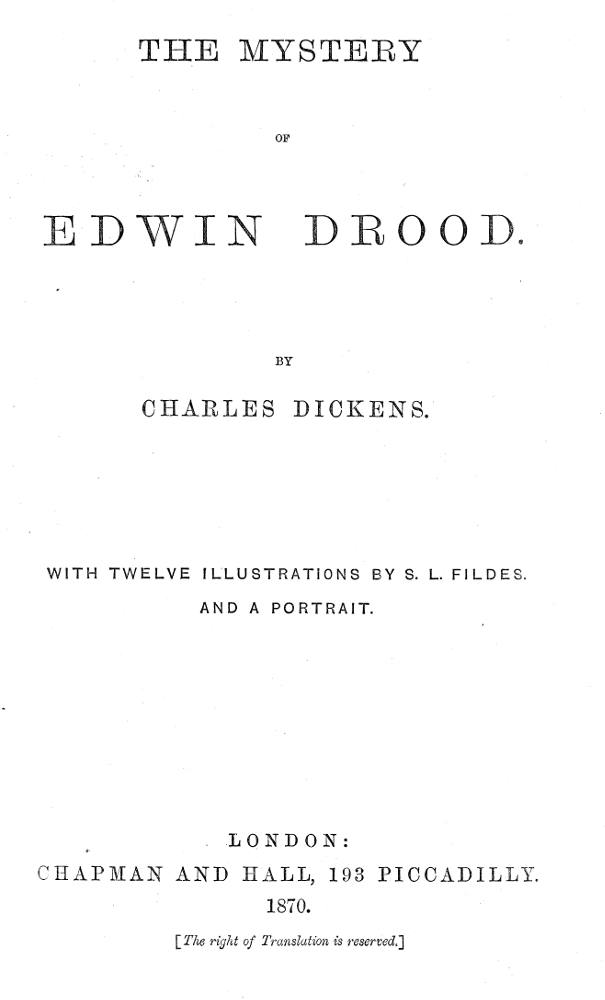
Each of the following plates appears within a bold, rectilinear frame of approximately 16 cm by 10 cm. Several scenes are set in London (no. 1 and no. 12 utilize as their backdrop an East End opium den that Dickens had actually visited with Inspector Charles F. Field of the London Metropolitan Police, while no. 10 is set in Grewgious's rooms in the Staple Inn, Holborn, West London). However, the majority are set in "Cloisterham," Dickens's name for Rochester, Kent, where he spent much of his childhood and outside which Gadshill, the mansion in which he died in June 1870, is located.
- 1870 Title Page for Edwin Drood
- 1880 Title Page [Master Humphrey and His Clock]
- 1. In the Court (April 1870)
- 2. Under the Trees (April 1870)
- 3. At the Piano (May 1870)
- 4. On Dangerous Ground (May 1870)
- 5. Mr. Crisparkle is Overpaid (June 1870)
- 6. Durdles Cautions Mr. Sapsea against boasting (June 1870)
- 7. "Good-Bye, Rosebud, Darling!" (July 1870)
- 8. Mr. Grewgious Has His Suspicions (July 1870)
- 9. Jasper's Sacrifices (August 1870)
- 10. Mr. Grewgious Experiences a New Sensation (August 1870)
- 11. Up the River (September 1870)
- 12. Sleeping It Off (September 1870)
In Charles Dickens and His Original Illustrators (1980), Jane R. Cohen in Chapter 17 shows the monthly wrapper drawn by Charles Collins (p. 215), and in Chapter 18 reproduces Fildes's unused sketch of In Rochester Cathedral from the Beinecke Rare Book and Manuscript Collection, Yale University. Finally, L. V. Fildes, the artist's son, in his biography mentions that Dickens proposed taking his young illustrator round the "Cloisterham" country" (p. 16), in particular, to visit the Maidstone Jail
so that the artist could see the condemned cell. The concluding illustration in the book, the twenty-fourth, was to be John Jasper in the cell waiting to be hanged for the murder of Edwin Drood. Dickens had told his illustrator that this concluding illustration must outvie Cruikshank's famous one of Fagin in the condemned cell in Oliver Twist.
That visit to Gad's Hill did not take place. On the morning of the day he was to have left London my father opened his paper and read the news of Dickens's sudden death.
Fildes's last tribute to the novelist he had only just met but for whom he felt a considerable regard was a plate of the writer's grave in Westminster Abbey's Poets' Corner, which appeared at the conclusion of John Forster's Life of Charles Dickens.
Related Materials
- Unravelling The Collins-Fildes Monthly Wrapper for The Mystery of Edwin Drood: The Solution to Dickens's Conundrum?
- Some Early Dramatic Solutions to Dickens's Unfinished Mystery
Scanned image, colour correction, sizing, caption, and commentary by Philip V. Allingham. [You may use this image without prior permission for any scholarly or educational purpose, as long as you (1) credit the person who scanned the image, and (2) link your document to this URL in a web document or cite the Victorian Web in a print one.]
Bibliography
Cohen, Jane R. "Chapter 18: Luke Fildes." Charles Dickens and His Original Illustrators. Columbus: Ohio State U. P., 1980. Pp. 221-234.
Dickens, Charles. The Letters of Charles Dickens, ed. Graham Storey. Oxford: Clarendon, 2002. Vol. 12 (1868-70).
_______. The Mystery of Edwin Drood. With Illustrations [by Sir Luke Fildes, R. A.] London: Chapman and Hall Limited, 193, Piccadilly. 1870.
_______. The Mystery of Edwin Drood; Reprinted Pieces and Other Stories. With Thirty Illustrations by L. Fildes, E. G. Dalziel, and F. Barnard. The Household Edition. London: Chapman and Hall, 1879. Vol. 20.
Fildes, L. V. Luke Fildes, R. A., A Victorian Painter. London: Michael Joseph, 1968.
Forster, John. The Life of Charles Dickens. In two volumes — with illustrations. The Charles Dickens Edition. London: Chapman and Hall, 1870. Vol. II (1847-70).
Kitton, Frederic G. Dickens and His Illustrators: Cruikshank, Seymour, Buss, "Phiz," Cattermole, Leech, Doyle, Stanfield, Maclise, Tenniel, Frank Stone, Landseer, Palmer, Topham, Marcus Stone, and Luke Fildes. Amsterdam: S. Emmering, 1972. Re-print of the London 1899 edition.
Paroissien, David (ed.). "The Illustrations," Appendix 3 in Charles Dickens's The Mystery of Edwin Drood. London: Penguin, 2002, pp. 294-299.
Walters, J. Cuming. The Complete "Mystery of Edwin Drood" by Charles Dickens: The History, Continuations, and Solutions (1870-1912). With a portrait [by Fildes in 1870]. Illustrations by Sir Luke Fildes, R. A., [and] F. G. Kitton. Facsmiles and a bibliography. London: Chapman & Hall, 1912.
Created 9 July 2005 Last modified 17 July 2023